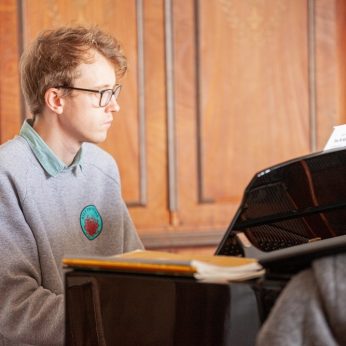Composer: Ernő Dohnányi (b. 1877 - d. 1960)
Performance date: 01/07/2022
Venue: St. Brendan’s Church
Duration: 00:18:28
Recording Engineer: Simon Cullen, Ergodos
Instrumentation: pf
Instrumentation Category:Solo
Artists:
Joseph Havlat -
[Piano]

Ernő Dohnányi [1877-1960]
Selections from Ruralia Hungarica Op.32a [1923-24]
1. Allegretto, molto tenero
2. Presto, ma non tanto
3. Andante poco moto, rubato
4. Vivace
This work comprises seven movements in total, inspired by a collection of 150 Hungarian Transylvanian Folksongs that had recently been published by Béla Bartók and Zoltán Kodály, although his style is typically more conservative than theirs. He was so taken with the Ruralia Hungarica that he arranged various movements for duos, orchestra and ballet. The movements vary widely in style, from the virtuosic to the delicate, from lively dance to meditative serenity, and certainly remind the listener that he was an incredibly talented pianist. While his early work was Late Romantic in style, from 1915 his work became more nationalistic and he incorporated the traditional music of Hungary, but his Romantic influences are still very much in evidence. Dohnányi achieved great international success as a pianist and in his native Hungary was appointed conductor of the Budapest Philharmonic and associate director of the academy of music. Despite different musical outlooks to Bartók and Kodály, he consistently promoted their work. In his positions of responsibility, he resisted the anti-Semitic laws of the pro-Nazi government during the war, refusing to fire Jewish musicians from orchestras and ensembles, and signing dozens of documents that allowed Jewish musicians and their families to escape from Nazi occupied territory. However, because he never sympathised with pro-Communist groups that took power after the war, his music was banned in Hungary for ten years. His choice to remain steadfastly in the middle ground led to much undeserved criticism from his detractors, but he remained for the rest of his life an avid musician, composing and touring right to the end of his life. He died at age 83 during a recording session.
The first movement of the Ruralia Hungarica is bright and clear, showing off the beautiful tonality of the instrument. The second movement has strong folk elements, brisk and rhythmic, with interesting chordal harmonies; its edgy opening is succeeded by a lighter hopping section, though still with the strong percussive rhythms. The third movement opens softly, sad and sweet. Elements of this movement may remind listeners of Debussy’s impressionism. The Vivace is driving, unstoppable, and still with the intriguing harmonies of the impressionist. The movement ebbs and flows from bright to subdued, but still always moving and finishing with a triumphal flourish.
Helen Dawson
Copyright © 2024 West Cork Music. All rights reserved.
Designed and developed by Matrix Internet